Marijuana shops across the United States are getting some work done – a tuck here, some implants there and sometimes an entire facelift.
Call it “Extreme Makeover: Dispensary Edition.”
Pot shops, once the sparsely decorated storefronts more concerned about DEA raids and federal seizures than LED display lights and high-end fixtures, are coming into their own in 2016. They’re hiring big-name architects and trendy design firms. They’re rebranding using mood boards and open-staff discussions on aesthetics. And they’re reinventing the way consumers shop for cannabis.
“We’ve got an LP player in the back, and we play records during the day so when people come in they have that aural sensory thing going on,” said Brendan Hill, co-founder of Paper & Leaf cannabis shop on Washington state’s Bainbridge Island and a founding member of rock band Blues Traveler. “When you hear Rod Stewart or the Police or the Grateful Dead or Buddy Rich and people are instantly taken back to the summer of ’85 when they had that really great road trip with a bunch of friends, it means something.
“Shopping here is all about feeling connected.”
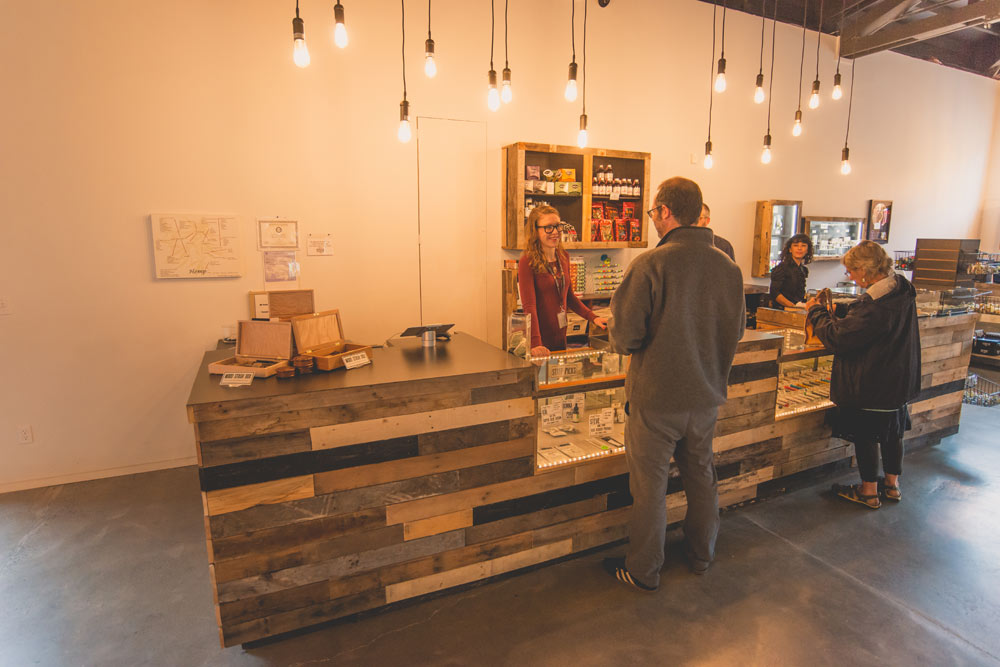
Paper & Leaf’s warm wood tones and elegant, art gallery-styled presentation match Bainbridge’s own natural beauty and well-to-do residences. Similarly, a dispensary group looking to make a splash in Sin City wanted its marijuana shops to flash with attitude and color.
“Because we have three locations in Vegas, we really wanted a design that had a little Vegas flair to it,” said Amy Almsteier, who designed the Blum shops in Nevada and California and is the branding manager for its parent company, Terra Tech. “They are still medical (in Nevada), and it was important to the local government that these shops feel like a doctor’s office. So I thought, ‘Well, why don’t we make it more like a plastic surgeon’s office?’ ”
Rapid design evolution
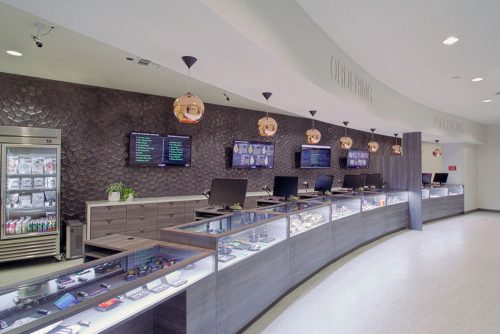
As Blum’s Las Vegas store’s sleek, futuristic design suggests with its custom tiles and chic copper lighting, cannabis shops are maturing. In 2014, a marijuana industry publicist controversially told The New York Times that dispensaries “look like underground abortion clinics.” Today the Clinic, which operates pot shops in Colorado, Illinois and Nevada, opens its new flagship store in Denver – and its build-out cost the company more than $1 million, 10 times as much as one of the Clinic’s first shops.
“Let’s be industry-agnostic here,” Scott Thorn, the Clinic’s president and COO, said earlier this week while showing off the new recreational and medical shop at 2020 S. Colorado Blvd. “We wanted to create a retail experience that measured up to stores in any industry. We wanted to be able to translate our brand into a physical and operational environment.”
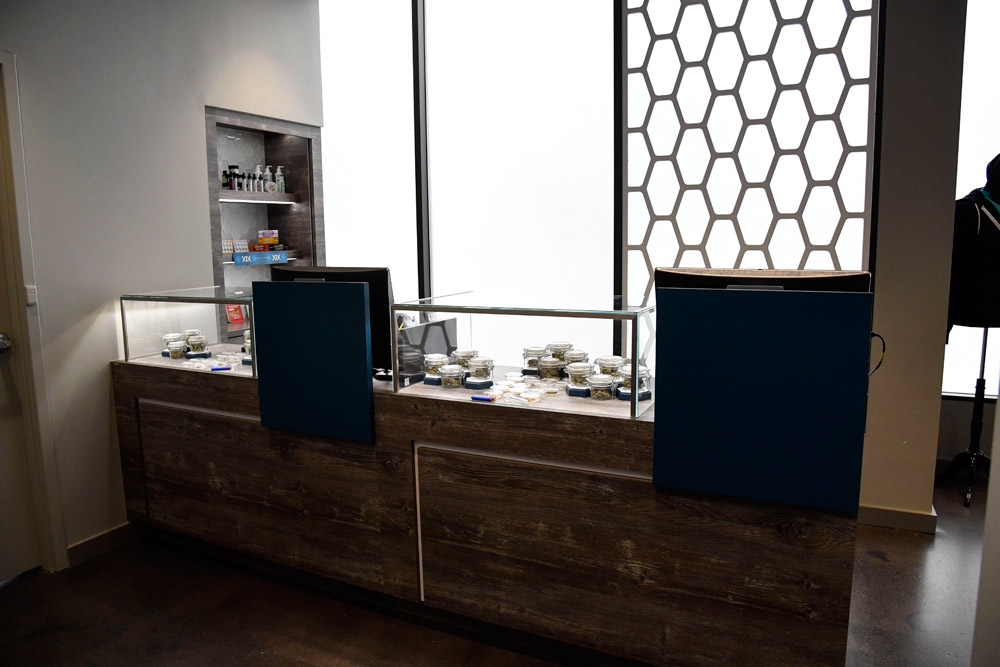
The Clinic spent $150,000 to build out its first Colorado medical marijuana dispensary in November 2009. The company spent $100,000 on its second location. Clinic director of operations Ryan Cook said the leap forward to a million-dollar facility creates a new standard and an actual prototype for all Clinic locations moving forward – including their Las Vegas shop, which will open in the coming weeks.
“To look at our earliest shops, which had great style for a new dispensary concept, and go from there to this facility where we put roughly a million dollars into it – or a little over a million, actually – it definitely shows,” said Cook.
Eye on the hot cannabis trends
Celebrate: This woman throws the swankiest, most luxe cannabis parties in America
Skyrocketing sales: Colorado pot shops set record with $117 million in sales for April 2016
The future: Why a pot shop hired Colorado’s best architect
Weed news and interviews: Get podcasts of The Cannabist Show.
Subscribe to our newsletter here.
Watch The Cannabist Show.
Peruse our Cannabist-themed merchandise (T’s, hats, hoodies) at Cannabist Shop.
The new Clinic location certainly stands apart. The first thing customers will notice in the ID-checking vestibule as well as the store’s open-floor layout is the warm natural light filling the space. A massive skylight is cleverly secured with custom metal millwork designed in the brand’s familiar molecule/honeycomb shapes. The wall along South Colorado Boulevard is all opaque, hurricane-glazed glass – “so it’s essentially unbreakable,” Cook said – that softly filters more natural light during the day.
An exceptional extracts display
The shop’s “art-meets-science” aesthetic makes sense given that they’re selling a drug that harnesses powerful and mysterious cannabinoids – some of which are potently psychoactive, most of which remain largely unstudied because marijuana’s federal illegality makes research difficult.
The storefront’s concentrates bar is perhaps its most striking and unique inclusion. The glass-covered bar artfully displays two different 50-gram slabs of extracts such as shatter or live resin – a segment of the industry that has seen major sales increases since the medical-only era. That the extracts display is so prominently featured is no accident; In 2013, extracts and concentrates (not including edibles) made up 7 percent of the Clinic’s total retail sales. In 2016 extracts make up 33 percent of the Clinic’s total retail sales, marking a nearly 400 percent increase in that category in less than three years.
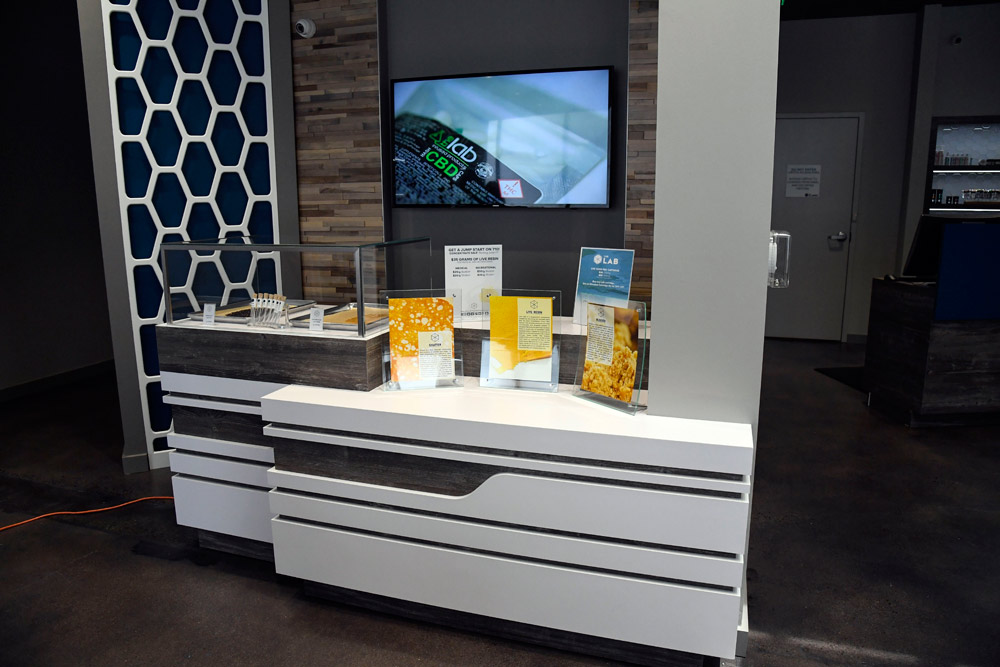
The importance of quality retail design shouldn’t be underestimated, though it should go largely unnoticed by the customer when it’s done well. Retail design experts say a store’s architecture, layout and branding is a “silent salesperson” that engages customers when the staff is occupied. From there the formula’s pretty simple: The more customers are engaged, they longer they stay and the more money they spend.
When Denver marijuana shop Good Chemistry secured a cannabis license in Aurora, owner Matthew Huron assembled a team that included brand strategists, graphic designers, architects, interior designers and others to create his new flagship store. The result is a smart and clean space that intelligently educates as it sells the Good Chemistry brand.
“The core value of our company is the passion and dedication and commitment to growing the finest cannabis we can possibly grow,” Huron said. “We viewed the Aurora store as a window into that dedication and passion that we have. We also wanted it to be a place where customers can continue to learn and explore and navigate through the world of cannabis.”
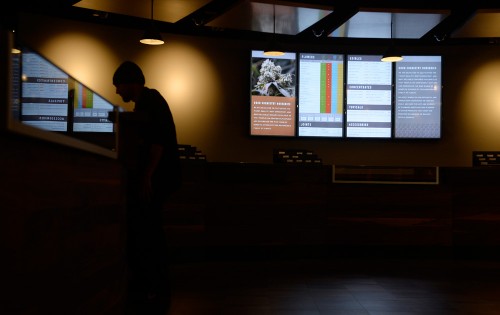
Good Chem’s Aurora store, with its plainspoken educational components and kiosks that provide an opportunity for more depth, was so warmly received that Huron and his team immediately brought the branding elements they could to their comparably tiny storefront on East Colfax Avenue in Capitol Hill, “but there are a lot of limitations there.” With the recent acquisition of an adjacent property, the 1,000 square foot space could soon nearly triple in size, paving the way for a Denver flagship in 2017.
Huron found out that thoughtful retail design works. But shoddy retail design can drive – and keep – customers away.
“It’s important throughout any retail experience for someone to feel comfortable and welcome,” said Paper & Leaf’s Hill, who noted that Bainbridge Island’s neighboring wineries and tasting rooms have recently started to reach out to him about potential collaborative tours. “We used to be the red-haired stepchild, but now we’re a part of the fold.”
Weed resources
What are the shops selling? Check out our marijuana reviews organized by type — sativas and sativa-dominant hybrids, ditto with indicas.
Follow The Cannabist on Twitter and Facebook
As these cannabis business owners continue to invest millions into well-designed stores, some also acknowledge that they’re fortunate to be able to focus on the presentation of their product in these keenly curated storefronts – whereas their predecessors had more pressing concerns.
“Open up, throw some paint in there and put some carpet in – that’s the extent of the renovation we saw in the early days of 2010-2012,” said Derek Peterson, CEO of Blum owner Terra Tech and Almsteier’s husband. “But now everybody is walking into a brand-new industry that is firmly regulated. Nevada is a benchmark state in terms of regulating vice industries. These business owners knew the state was going to stand up for the industry. They knew the federal government wasn’t going to come in and stop it.
“And because it’s Vegas, we’re all stepping up our games. It’s not $1.99 steaks anymore. It’s celebrity chefs and big nightclubs.”
Added Paper & Leaf’s Hill: “We feel so lucky to be in the era where it is legal in our state for recreational and medicinal marijuana to be sold out in the open, and we can have an open communication about it. And kudos and much props to all the people who went before us who did take all those risks and were open for years and years with that constant threat of being closed down or having their property seized. We’re entering the industry in the last year or two, but we want to give them lots of props for paving the way and being the true frontiersmen.”
